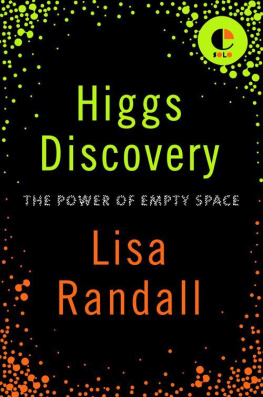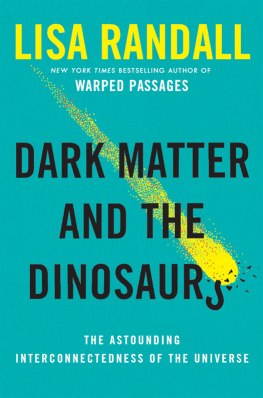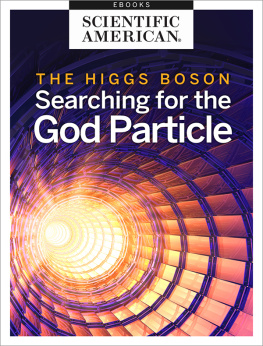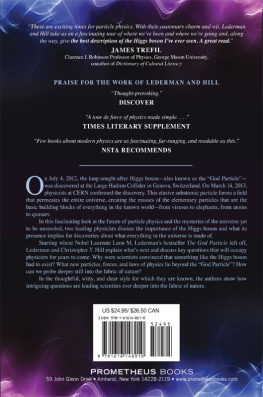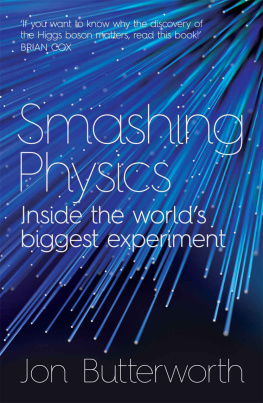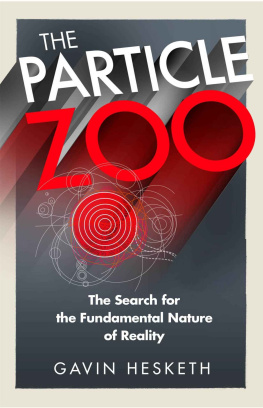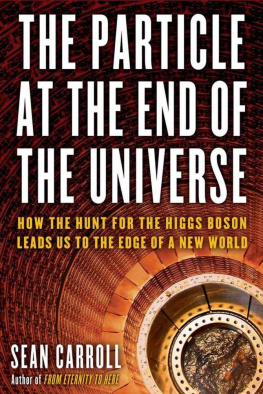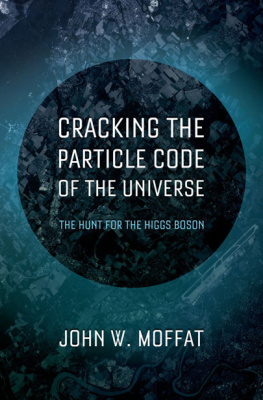
HIGGS DISCOVERY
The Power of Empty Space
LISA RANDALL

Contents
On July 4, 2012, along with many other people around the globe who were glued to their computers, I learned that a new particle had been discovered at the Large Hadron Collider (LHC) near Geneva. In what is now a well-publicized but nonetheless stunning turn of events, spokespeople from CMS and ATLAS, the two major LHC experiments, announced that a particle related to the Higgs mechanism, whereby elementary particles acquire their masses, had been found. I was flabbergasted. This was actually a discovery, not a mere hint or partial evidence. Enough data had been collected to meet the rigorous standards that particle physics experiments maintain for claiming a new particles existence. The accumulation and analysis of sufficient evidence was all the more impressive because the date of the announcement had been fixed in advance to coincide with a major international physics conference occurring in Australia that same week. And what was more exciting still was that the particle looks a lot like a particle called the Higgs boson.
A Higgs boson is not just a new particle, but a new type of particle. The thrill in this particular discovery was that it was not simply a confirmation of definite expectations. Unlike many particle discoveries in my physics lifetime, for which we pretty much knew in advance what had to exist, no physicist could guarantee that a Higgs boson would be found in the energy range that the experiments currently coveror even found at all. Most thought something like a Higgs boson should be present in nature, but we didnt know with certainty that its properties would permit experiments to find it this year. In fact, some physicists, Stephen Hawking among them, lost bets when it was found.
This discovery confirms that the Standard Model of particle physics is consistent. The Standard Model describes the most elementary components that are known in matter, such as quarks, leptons (like the electron), and the three nongravitational forces through which they interactelectromagnetism, the weak nuclear force, and the strong nuclear force. Most Standard Model particles have nonzero masses, which we know through many measurements. The Standard Model including those masses gives completely consistent predictions for all known particle phenomena at the level of precision of a fraction of a percent.
But the origin of those particle masses was not yet known. If particles had mass from the get-go, the theory would have been inconsistent and made nonsensical predictions such as probabilities of energetic particles interacting that were greater than one. Some new ingredient was required to allow for those masses. That new ingredient is the Higgs mechanism, and the particle that was found is very likely the Higgs boson that signals the mechanisms existence and tells how it is implemented. With improved statistics, which is to say with more information after the experiments run longer, we will learn more about what underlies the Higgs mechanism and hence the Standard Model.
Though a discovery was indeed announced, it was in fact made with some of the caution I had come to expect from particle physics announcements. Because the measurements had identified barely enough Higgs boson events to claim a discovery, they certainly didnt yet have enough data to measure all the newly discovered particles properties and interactions accurately enough to assure that it is a single Higgs boson with precisely the properties such a particle is expected to have. A deviation from expectations could turn out to be even more interesting than something in perfect accord with predictions. It would be conclusive evidence for a new underlying physical theory beyond the simple model that implements the Higgs mechanism that current searches are based on. This is the sort of thing that keeps theorists like me on our toes as we try to find matters underlying elements and their interactions. Precise measurements are ultimately what tell us how to move forward in our hypotheses. The Higgs boson is a very special particle indeed and we ultimately want to know as much as we can about it.
Whatever has been found the Higgs boson, the particular implementation of the Higgs mechanism that seems simplest or something more elaborateit is almost certainly something very new. The interest from the public and press has been very gratifying, indicating a thirst for knowledge and scientific advances that humanity to a large extent shares. After all, this discovery is part of the story of the universes evolution as its initial symmetry was broken, particles acquired masses, atoms were formed, structure, and then us. News stories featured members of the public who were fascinated but werent necessarily quite sure by what. Perhaps the ultimate recognition of the pervasiveness of Higgs boson awareness was the appearance of jokes and spoof news stories indicating the interestbut also some of the bewilderment.
So Im writing this to respond to many of the questions Ive been askedto share what the discovery means and to explain a bit about where it takes us. Some of what Ill say is already in chapters from my previous books, Warped Passages and Knocking on Heavens Door , two of which are appended. Those books didnt isolate the Higgs boson for extra special attention; rather they covered many topics, including information about the collider, the larger physics story for which this is the capstone, and the nature of science itself. They give the larger context of which this discovery is onealbeit a very importantpart. But at least for the time being, the Higgs boson deserves its moment in the limelight. So in addition to those older chapters about the Higgs particle, this book offers a few new (and old) thoughts. Its an unbelievably exciting moment in physics and Id like to share some of what occurred and what it means.
T HE C HALLENGE OF D ISCOVERY
I guess I was better off on July 4, 2012, than during the last Higgs report in December 2011. On the earlier date, I woke up before five in the morning to do an interview and to listen to talks from CERN, as I was in California and the time zone was not very congenial. At the time of the recent announcement, on the other hand, I found myself on a Greek island where I was taking an all too rare vacation. Although I had poor Internet connectivity and was isolated from my colleagues, at least I was only one time zone away when Joe Incandela, the spokesperson for CMS, first took the stage. Because my somewhat rustic apartment had no Internet, I first learned of the Higgs discovery while sitting in a balcony cafwhich happily for me opened at 10 A.M. , the time of the talks.
In fact, I hadnt imagined when making my holiday plan that this would happen. I had known the Higgs evidence would increase, but I hadnt known that the engineers would have done such a heroic job in increasing the collision rate, and the experimenters an equally impressive improvement to their analysis methods, that would allow the speakers on July 4 to say with certainty (by physicists standards) that a particle had been found. One other factor that contributed to the Higgs boson discovery was the decision to run at slightly higher energy8 TeV rather than the 7 TeV of the previous yearwhich by itself increased Higgs production by about 30 percent. I was very grateful to the Internet for keeping everyone connected and to Twitter for providing an outlet for my excitement (and for sharing information once people caught on to what was happening and the connection diminished in quality).
Maybe to compensate for that disconnect, I spoke a few days later on a radio program on WNYC. In the pre-show discussion that one typically has before such a program, we reviewed the types of topics that might arise. Most were ones I was prepared for. But I was a little flustered when I was told I would be asked to compete with Dennis Overbyes delightful description of the Higgs boson discovery: Like Omar Sharif materializing out of the shimmering desert as a man on a camel in Lawrence of Arabia, the elusive boson has been coming slowly into view since last winter... ( New York Times, July 4, 2012).
Next page
